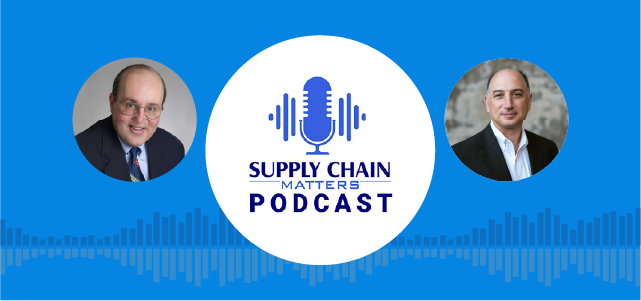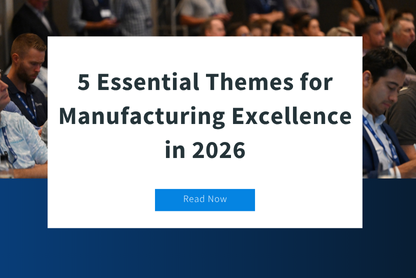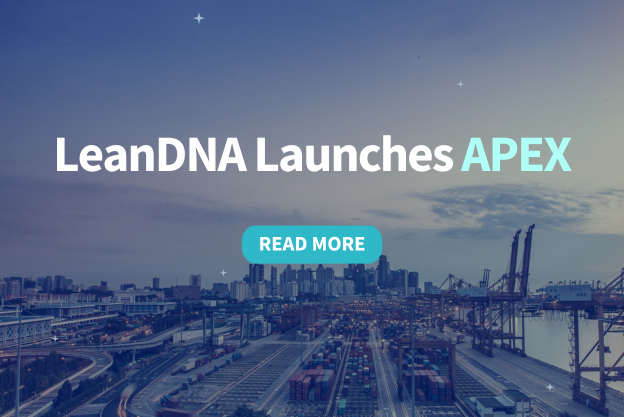Earlier this week, the “Supply Chain Matters” podcast, hosted by industry analyst Bob Ferrari, featured LeanDNA CEO Richard Lebovitz to discuss themes such as new manifestations of lean, connected manufacturing, and more. “Supply Chain Matters” is widely regarded as one of the top internet blogs in the field of supply chain management. This installment of the podcast can be found and listened to here. Read the full transcript below to learn how lean manufacturing is transforming for today’s supply chain complexities.

Transcript
Bob Ferrari:
Hello to all listening and welcome to episode 13 of our Supply Chain Matters podcasting series. I am Bob Ferrari, the founder and executive editor of our blogging platform and I will be serving as moderator of this podcasting series. The Supply Chain Matters blog is consistently rated as one of the top blogs in supply chain management thought leadership. And since our founding in 2008, we have garnered a global-wide readership. This podcast medium serves as a supplement to the various published content on Supply Chain Matters and is our opportunity to present a more two-way conversational discussion to important topics.
Bob Ferrari:
And indeed this particular episode is an important topic in manufacturing. As multi-industry supply chain and manufacturing management teams continue to tackle just an endless challenge of disruptions, we are featuring a series of recognized thought leader guests that are experts in specific business process and technology areas. And in that light, I am pleased to have as my guest for this episode, Richard Lebovitz. Richard is a 30-year lean manufacturing expert and the founder and CEO of LeanDNA, a cloud-based actionable intelligence platform for factory management.
Bob Ferrari:
Richard is a widely recognized thought leader in lean thinking and just-in-time manufacturing. Prior to LeanDNA, Richard was founder and CEO of Austin-based Factory Logic, which he started in 1997. He built Factory Logic into a leading provider of software that models the Toyota production system and won the Shingo Prize for manufacturing excellence in 2001. So if there were ever an expert in just-in-time, Richard is our guy. So Richard, welcome to the podcast.
Richard Lebovitz:
Hello Bob, thanks for the opportunity to join you today. As Bob mentioned, I'm Richard Lebovitz, CEO and founder of LeanDNA. I've been working in lean manufacturing and supply chain for the last 30 years. And my focus has been on bridging the gap between the domain side of lean manufacturing and building technology to help optimize the way these systems need to work together. Our product is called LeanDNA, which is a factory-centric, execution-focused SaaS analytics platform that can quickly connect to any ERP system and empower supply chain teams to reduce excess inventory, improve on-time delivery by reducing shortages, and ultimately establish what we call operational command. Bob, thanks for letting me join you today.
Bob Ferrari:
It's my pleasure, Richard. So let's begin with maybe you can for our audience, listening audience, briefly describe your career as it relates to lean thinking and process practices and how that has facilitated development of technology to support these various practices in various manufacturing and factory-controlled environments.
Richard Lebovitz:
Yes, some key themes in lean thinking, Bob, are speak with data, waste elimination, establishing clear measurements and goals, and, most importantly, would be how do you make work easier for people? My focus over the years has been on combining this type of lean thinking in developing technology to help improve the analytical tools and workflow automation for what we call factory operations management.
Richard Lebovitz:
Factory operations management is the execution of inventory optimization practices at the factory level, including the people, the processes, and tools used to optimize inventory and improve on-time delivery. When I first started in this area, as Bob mentioned, about 30 years ago, lean was actually a relatively new concept. Now today, every manufacturer has teams focused on deploying and optimizing these processes. The reality is that forecast-driven plans are always going to fall short and our technology was built to improve the tactical execution in factories, which is often unfortunately performed in Excel even today.
Richard Lebovitz:
The goal is to help improve the daily workflow in factory supply chain optimization, which is an area often ignored in the end-to-end supply chain planning solutions being deployed today. Another major opportunity today is the visibility and communication links between factories and suppliers is currently very manual. We found that by leveraging advanced analytics to prioritize these actions and then communicate this information in a more automated way to the suppliers, we can make sure that these suppliers are making the right parts at the right time in the right order.
Richard Lebovitz:
If not, we have suppliers investing capacity in making the wrong parts, which creates excess inventory. While at the same time, they're not making what is really needed, which is causing shortages. A lot of what you see in the paper today, Bob, is around these types of problems, which we see across the supply chain where you have a factory struggling with shortage, while at the same time they have excess inventory. So the net result of what I've been trying to do over the years, and doing it through technology linked to our domain expertise, is trying to achieve both where we can get the reduced excess inventory, but at the same time, improve delivery through reduced shortages.
Bob Ferrari:
Let's stay with that theme because that's a good one right now with so many industry supply networks, including manufacturing plants more driven by the outside in forces or what we call outside ins such as added product customization or conflicting needs of highest sufficiency versus added flexibility. And the notions of today's widespread component shortages, which you just mentioned. How do you view these seismic changes and how are they occurring now in manufacturing as you see them?
Richard Lebovitz:
Yeah, the factory used to be considered a black box, but now it's becoming a strategic component to the business, which has not always been the case. There has been significant investments in factories around like shop floor automation and robotics and MES and data acquisition. There's also been significant investments in ERP and planning system, but in this area what we call factory operations management, it's still primarily Excel. These types of tools worked five, 10 years ago, but they are not effective today due to the increasing product complexity and supply chain expansion and globalization that these factories now have to deal with.
Richard Lebovitz:
There was a belief that you could establish a good planning or SysOps process and just hand it off to the factories and those parts would get made. But in the end, this has led to a lot of finger pointing and long weekends for those people that actually have to run the factories. So factory operations need tools to support this tactical daily execution and decision-making. And the goal is to leverage technology to make the work easier for people and shift their focus to be more strategic and spend more time actually working on improving the business performance.
Bob Ferrari:
And on the same theme of shortages, it's reached a point where it's now made the headlines of the Wall Street Journal. We talked a little bit before about that article on Whirlpool that the Wall Street Journal published, which was an excellent example of what you just described as the constant changing that's driving manufacturing planning teams crazy right now. And now with global automakers, we've got the global-wide shortage of semiconductors and that's causing a lot of discussion about rethinking just-in-time inventory management practices. Are these constant flexing by manufacturers ideal or how do manufacturers really cope with this?
Richard Lebovitz:
Yeah, it's a good question. We actually were quoted in a recent New York Times article about this very topic, Bob, and the reality is just-in-time is typically applied to a few number of parts within the factory and often in only certain industries. So we need to separate this concept of just-in-time inventory from pull replenishment strategies, which is really a way of signaling more accurately how we need to have parts delivered from suppliers.
Richard Lebovitz:
So the best approach in reality is to leverage this hybrid strategy where you combine pull for those parts that are high volume stable runners, where you can put them on a system where it just manages itself and then have those other parts using traditional MRP for what we call strangers. And that's going to be the long tail of your product quantity analysis curve. So issues will always happen, but this gives you the best approach to handle whatever comes your way. It gives you that flexibility, the efficiency, and delivering improvements all within the same system.
Bob Ferrari:
Yeah. And for our listeners who are practitioners in the supply chain management, this is kind of similar to supply chain segmentation, where you basically you look at the process and you try to differentiate the traditional just-in-time inventory, which is very predictable as opposed to one that's going to be customized or is going to flex, which is going to require that hybrid model, right?
Richard Lebovitz:
Exactly, Bob. Yeah and that's the key. And a lot of times people group all that together. And so then they have challenges with this kind of strategy, like everything's on combo and or nothing's on a pull system. And even within the pull system, there was a reorder point, there's a multi-band Kanban, there's a min-max. And so those strategies are always, what we found, are not always very clear within these factories. And what we try to do is help establish the right strategy and then give the execution tools to actually help manage that.
Bob Ferrari:
Good, good. So as you know, there are multi-industry examples that include a very much more quick and clock speed of business changes that are now occurring across many, many industries. How do you describe them right now? And maybe you can provide our listeners with a couple of good examples of LeanDNA customers and how they are responding, as well.
Richard Lebovitz:
So what I'll do is I'll kind of give you my perspective, Bob, and then I'll hit on a few real examples from a couple of industries within our customers. And I think one of the challenges that I see right now with existing supply chain solutions is when they come in to make improvements, they're really built to re-engineer the way a company's supply chain is designed. And that's not really what we need right now, especially when the demand plans might be obsolete tomorrow. And in the end, everybody's pointing fingers at we need better planning and better aggregation of data.
Richard Lebovitz:
And I believe and what I've seen is they've been saying the same thing for 20 years. The way you can handle change in today's complex environment is through better execution, not planning. And unfortunately, most of the end-to-end planning systems are just more of the same. The goal in my opinion is to be able to connect to the existing ERP systems very quickly and provide that out of the box workflow and advanced analytics that will help them reduce excess inventory while at the same time improving on-time delivery.
Richard Lebovitz:
The key is to have the best practices, workflow, methodology built into the tool. We know it works and it's really what's needed today, but the problem is, from what we see, Bob, is that these solutions have been built behind the scenes by factory teams using Excel or custom solutions. And in many cases, they've been just working around IT to get it done. So my goal at LeanDNA and with the companies we work with is to build a solution that many modern factories were often creating internally in Excel because they didn't have the system support or the domain knowledge of how to build an automated solution.
Richard Lebovitz:
They also lack the ERP integration and data transformation knowledge to make these analytics really work and produce results. So that's the area that we really focus on. And maybe just to hit on a couple of quick examples. So one example would be at a large aerospace customer bar. And in this sector, there is a high degree of product customization by aircraft. And this is often referred to as, like, a ship set or tail number where each aircraft has slight differences. And when you look back, let's say 10 to 15 years ago, you just wanted the aircraft to fly safe and efficient. Now it's what seat back interiors do you want? What type of electronics? What cabin configuration?
Richard Lebovitz:
So in addition to that high degree of customization, there are thousands of suppliers across multiple tiers where material delivery has to be synchronized with these specific aircraft configurations. And just keep in mind that it takes just one part in some cases to actually stop the line. So we've been able to create a platform that's actually now being used by some of the largest tier one aerospace manufacturers in the world that can identify current and future shortages, prioritize the actions, and then enable real-time collaboration with suppliers to get these issues resolved. And what we've basically done is automated what's typically called a line of balance linked to a clear-to-build process that's often used by leading modern manufacturers, but it was just all Excel-based.
Richard Lebovitz:
The second example I would use, which is, I know we did a recent webinar book, Bob, with Ingersoll Rand and that's in the industrial product sector where this industry does not have the level of complexity you would see like, let's say in aerospace, but they're seeing the same opportunities to improve the factory's ability to manage shortage while at the same time reducing excess inventory. They often have this hybrid mix of Kanban for pull and then use MRP-driven procurement that's actually based on a forecast. And in this case, we're able to leverage our LeanDNA platform to streamline the sizing and management of their Kanban items while putting in place a system to manage the MRP-driven items.
Richard Lebovitz:
While these MRP items often represent a small amount of spend versus Kanban or reorder point, it's actually a large number of parts. And, as I mentioned earlier, it just takes one of those items to create a shortage. So the goal is to manage both, but there's very different strategies in terms of how each one is handled.
Bob Ferrari:
Yeah. Yeah, I remember that. That was a good articulation by the head of their supply chain as to exactly what the problem was. So, let’s shift a little bit. We're recording this in the US, hopefully we’re approaching this post-COVID-19 era, but COVID-19 did disrupt many industries, supply chains with somewhat measurable and unforeseen impacts, others with new market opportunities that were presented. And we're all writing about them and you have recently written a guest post on Supply Chain Matters on the new manifestations of lean as well as connected manufacturing that will transform modern manufacturing. Could you describe for our listeners some of the prominent areas that you observed in that piece?
Richard Lebovitz:
Sure, Bob. So the first I would say is like this classic just-in-time thinking is not well understood and you see that in the press today. It is not about zero or just enough inventory. The modern lean factory uses a hybrid pull-push replenishment model that I mentioned that optimizes inventory balance based on supply network risk and resiliency. This uses electronically-managed and monitored Kanban or reorder point processes that are designed in close collaboration with suppliers. MRP or PTO, which is often like purchased order processes, are still leveraged, but for those low volume parts.
Richard Lebovitz:
The key is to automate the repeatable activity so that your team can actually spend more time managing the complexity or the complicated parts. So that's one area. The second area is to reduce the reliance on static spreadsheets in favor of technology applications that integrate and transform real-time data, create purpose-built workflows geared towards buyers, planners, analysts, and also has out of the box electronics dashboards providing this end-to-end visibility into the factory and supply chain.
Richard Lebovitz:
I would say the third area is to improve decision-making and action prioritization. And within this, the goal is to provide users with, what are the top three to five actions they need to take that day that's going to have the biggest impact on the business? Right now, they're surrounded with sometimes hundreds of messages and they don't know what are the things that are most critical for them to do that day. And then to be able to do a quick root cause analysis of the issue so that they feel and understand the issue and are confident they're taking the right decision.
Richard Lebovitz:
And I would say the fourth is to integrate and connect factories and suppliers so that we can manage shortages and excess inventory across different sites and even different ERP systems so that we can leverage this cloud-based connectivity that exists today to establish and enforce best practices across the organization to help optimize for factory operations management.
Bob Ferrari:
Yeah, as I partook of some of the briefings from LeanDNA and looked at some of the functionality that you just described, I very much saw it's a technology tool for just-in-time in the new era kind of thing, where it helps to balance all these risk factors, is the way I see it.
Richard Lebovitz:
Exactly. And I think the issue is the data's there, but it's a combination of the right analytics, the domain expertise. How do you really leverage that? I would say going back 30 years, that was one of the things I'd always find with factories, that they lacked that kind of replenishment strategy and segregation, as you mentioned, to come up with the right way to manage the business. And without doing that, you're constantly firefighting and struggling. Once you get that in place and you combine it with the good tactical execution tools, then you can really see success both in reduced inventory and improved delivery.
Bob Ferrari:
Yeah, very much so. So let's turn a little bit towards the future and what we think is going to happen in this post-COVID era or the next normal, however you wanted to describe it. So, Richard, if you had a crystal ball, what would the next five years look like in terms of manufacturing capabilities and performance?
Richard Lebovitz:
Yeah, it's an interesting time for sure, Bob, given what we've seen over the last year and just how supply chain now is becoming such a key topic in the press and with companies. So the one thing I would say is factory operations management is one of the largest opportunities, in my opinion, for digital transformation and building lasting resiliency coming out of COVID. The technology has evolved where purpose-built workflow and advanced analytics can be leveraged to replace the existing spreadsheets, and often what's put in place, these BI solutions, that what we hear are really just reporting data.
Richard Lebovitz:
They're not helping them improve. They're kind of showing you how good or bad you're doing, but they're not making you better. And I believe that technology cannot only help prioritize the actions, but in fact, we are now using things like machine learning to help us learn from those specific actions and results to enable even smarter decisions.
Richard Lebovitz:
The second driver is the new generation of manufacturing leaders, the young generation that are now taking over factory management, want to bring information online, which I can tell you having worked in this area for years, and I was trained by my Japanese partners that are in their 70s or 80s now. They liked everything very manual and paper. Where now the new generation wants things to be much more digital. And just one real example is just four years ago, we had a major manufacturer say, "We don't do SaaS." And this same manufacturer now has aggressive plans to adopt these same technologies.
Richard Lebovitz:
I also believe that traditional enterprise supply chain solutions are often based on a very top-down approach, with little understanding of modern lean manufacturing operations. And we see the factory starting to be viewed as really, Bob, a critical link. And it wasn't always viewed that way. We see leading manufacturers rethinking how supply chains are managed and focus more on this factory-to-factory and factory-to-supplier optimization and tactical execution systems and less focus on the planning side.
Bob Ferrari:
Yeah. And let's stay on that theme as well in terms of predictions. Connected manufacturing, as a manifestation of linking internal manufacturing, as well as augmented contract manufacturing, kind of managed by a hybrid inventory management processes and workflow that you just described. How do you see factory-to-factory and factory-to-supplier connections evolving in this time window now?
Richard Lebovitz:
Yeah, and that's probably one of the biggest areas that we've been focusing on. We kind of are thinking as a supply chain of really turning us on a head versus kind of enterprise warehouses planning down to the factory. We want that to be back on top. And the good thing is that's actually happening today with many of our customers, that factory-to-factory and factory-to-supplier connections that you're talking about.
Richard Lebovitz:
And the data is there, but the problem was the analytical and collaboration tools were just missing. So by linking these tools with the purpose-built workflow I mentioned earlier, we are seeing the factory-to-factory and factory supplier connections starting to become normal operating procedures with a lot of the companies that we work for today.
Bob Ferrari:
Good, good. So, before we run out of time, I just want to get to one other perspective that I'd love to hear from you. And that is, what will be the most important key performance in lean manufacturing indicators in this next normal, from your perspective?
Richard Lebovitz:
So when you think about, in lean we use this term like an automotive that we call QCD; quality, cost, delivery. And when you think about it, it's easy to get one out of three. It's actually not too hard to get two out of three, but when you try to get three out of three, that's where it gets really, really challenging. But that's where lean linked with systems can actually make that happen. And so the good thing is that the metrics that we're seeing are really still the same. It's going to be, we want to improve on-time delivery, we want to reduce excess inventory, we want to improve quality, while at the same time lower operating costs.
Richard Lebovitz:
So those will still be the same metrics. So the goals have not changed, but we can now achieve these results with growing product complexity and growing challenges with the overall supply chain management if we can leverage technology and process and people all in the right way. So the good thing, to answer your question, Bob, I think it's an important topic, is the key measurements are still the same. But it's really making it happen with lower cost and making it easier for people to actually make that happen without having to work weekends, work overtime and trying to deal with a lot of firefighting.
Bob Ferrari:
Good, good. Richard, as always, this is a topic I think we could do two or three podcasts in, but we're sort of running out of time here, but I really want to thank you for sharing with our listeners your overview and perspectives relative to your experiences in lean thinking and business practices and connected manufacturing. And that means a lot from your roots in this area and I'm hoping our listeners will get some value out of that.
Bob Ferrari:
Any final takeaway thoughts that you'd like to leave with our listening audience regarding their plans and objectives related to manufacturing in this challenging time, and also how can listeners contact you directly?
Richard Lebovitz:
Well, so the first question I would say, the exciting thing for me is the factory and the supply chain is now being seen as a critical part of business operations. So what I would say is let's use this opportunity to leverage technology to drive real transformation in manufacturing, which is something that hasn't been done yet. And the more that we talk to analysts like yourself and we look at our customers, it's really this last big opportunity for digital transformation that really hasn't gone through a lot of automation.
Richard Lebovitz:
So that's kind of our goal for the future. In terms of contacting me, the best way to do it is via email I would say, which is Richard.Lebovitz@leandna.com. And again, Bob, thank you for the opportunity.
Bob Ferrari:
And thank you, Richard. It's been a great opportunity and a great pleasure to have you as our podcast guest. And this concludes our episode 13 podcast, New Manifestations of Lean Thinking and Connected Manufacturing with Richard Lebovitz.
Bob Ferrari:
Stay tuned to the Supply Chain Matters blog for additional commentary related to the two normal processes and decision-making needs. Similar to this episode over the coming weeks, we will provide further thought leaders with a focus on what to anticipate in the coming year in the new normal. Please feel free to contact me with your requests for additional timely topics. In the meantime, this is Bob Ferrari signing off until our next episode. And always remember, Supply Chain Matters do matter for successful business outcomes.
Want to see how LeanDNA can help you reduce excess inventory, prevent shortages, and improve on-time delivery? See it in action.






